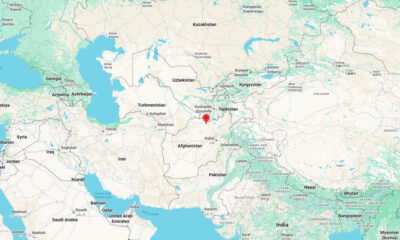World
NOAA warns of severe geomagnetic storm, auroras possible as far south as California

The National Oceanic and Atmospheric Administration (NOAA) has issued a Severe Geomagnetic Storm Watch (G4) as a powerful solar eruption is expected to impact Earth’s magnetic field, possibly triggering widespread auroras and minor disruptions to satellites and communications.
According to NOAA’s Space Weather Prediction Center, a series of coronal mass ejections (CMEs) have erupted from the Sun since Sunday, with the latest and most energetic blast linked to an X5.1-class solar flare that peaked at 5:04 a.m. ET on Tuesday.
The agency said this eruption is associated with a moderate solar radiation storm and could partially strike Earth’s magnetic field on Tuesday, with G4-level (Severe) activity possible.
Scientists said the timing of the storm is difficult to predict because multiple CMEs are moving through space simultaneously. NOAA forecasters have “high confidence” that the most recent eruption has an Earth-directed component, though the precise intensity will not be known until the solar wind is measured about 1 million miles from Earth.
If conditions align, forecasters said the storm could cause temporary disruptions to power grids, GPS, and high-frequency radio, while auroras may be visible as far south as Alabama and northern California.
The X5.1 flare, one of the strongest of the current solar cycle, originated from a highly active region of the Sun known as Region 4274. It followed several days of heightened solar activity, described by some astronomers as a “Veteran’s Day fireworks show” due to the timing of the eruption.
In May 2024, a similar series of powerful eruptions triggered the strongest geomagnetic storm in more than two decades. Auroras were visible as far as the Florida Keys, Puerto Rico, Spain, Algeria, India, Chile, and New Zealand. That storm temporarily disrupted some satellites and communications but caused no major infrastructure damage.
The most powerful event ever recorded, the 1859 Carrington Event, caused telegraph systems to spark and fail worldwide. A later storm in 1989 triggered a province-wide blackout in Quebec, Canada, leaving millions without electricity.
Today's X5.1 solar flare was the 6th strongest solar flare of the current solar cycle and it launched an impressive coronal mass ejection towards Earth. The plasma cloud could impact Earth as early as 16 UTC tomorrow (12 November) and this prompted the NOAA SWPC to issue a G4 or… pic.twitter.com/qabhn7Y5yZ
— SpaceWeatherLive (@_SpaceWeather_) November 11, 2025

-

 Breaking News1 week ago
Breaking News1 week agoAt least 3 dead, 11 injured after UPS cargo plane crashes near Louisville airport
-

 Politics2 days ago
Politics2 days agoSenate reaches deal to end record shutdown – CNN
-

 World1 week ago
World1 week agoStrong 6.3 earthquake strikes northern Afghanistan; felt across Pakistan
-

 World1 week ago
World1 week agoProtesters storm government building in Mexico after killing of local mayor
-

 US News6 days ago
US News6 days ago5 firefighters injured in vehicle explosion in the Bronx, NYC
-

 US News6 days ago
US News6 days agoFAA orders 10% flight cut at 40 U.S. markets as shutdown strains air traffic system
-

 US News6 days ago
US News6 days agoDeath toll rises to 11 after UPS cargo plane crash in Louisville
-

 Politics5 days ago
Politics5 days agoForeign hackers breach U.S. Congressional Budget Office – WaPo




